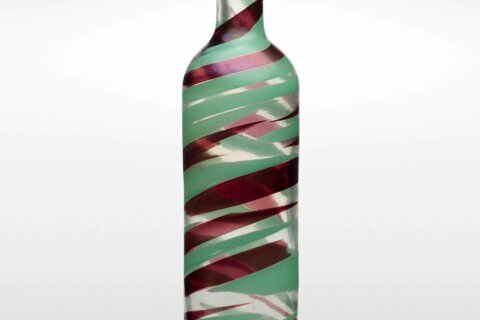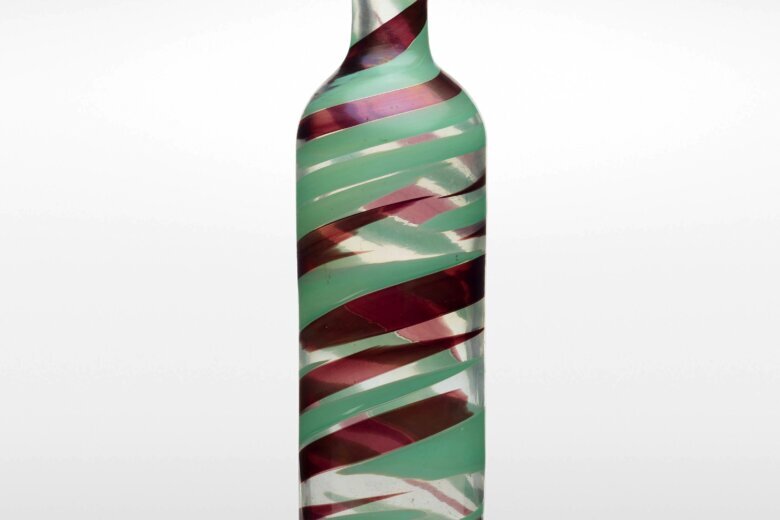
Jessica Vincent had just started surveying the shelves of a Virginia thrift store when a vase caught her eye. It was shaped like a bottle and had ribbons of color, aqua green and amethyst purple, that spiraled up its glass surface like stripes of paint.
The piece looked old amongst the clutter of measuring cups, candles and other tchotchkes. After adjusting her eyes, Vincent made out the words “Murano” and “Italia” on its base.
“I bought it thinking it would look beautiful in my house somewhere,” said Vincent, 43, a horse trainer who paid $3.99 at a Goodwill outside of Richmond. “I definitely didn’t buy it thinking, ‘Oh, I’m going to sell this.’ ”
Her thinking changed after some research. And on Dec. 13, the vase sold through the Wright Auction House for $107,100. The buyer, a top collector from Europe, wished to remain private.
Vincent’s purchase came after years of perusing yard sales and thrift stores with her mother. She loves PBS’ “Antiques Roadshow” and has daydreamed many times of this kind of lottery ticket-level transaction.
“I always felt like I had a good eye,” said Vincent, who visits thrift stores a few times a week with her partner. “But I’m really surprised that nobody picked it up before I did.”
The vase was likely on the shelf for only a couple days given its quality and the quick rate at which products are sold, said Laura Faison, a spokeswoman for Goodwill of Central and Coastal Virginia. Each store averages about 2,000 new pieces a day, and they often come in from a car’s trunk.
“It could have been someone cleaning out grandma’s basement,” Faison said of the vase’s backstory. “We’ll probably never know.”
Vincent arrived at the Goodwill on a June afternoon with her partner, Naza Acosta, after a day of training horses. The vase felt heavy in her hands. And while Vincent had seen painted glass before, the vase’s swirling colors were different. They came from the glass itself, she said, “and it was just so delicately done.”
Back home, Vincent posted photos in Facebook groups for glass art and soon joined a private one for Murano glass.
The “Murano” on the vase’s bottom referred to the island in Venice that has been famous for its glasswork since the 13th century. Its highly prized creations have included ornate crystal chandeliers and mirror frames, many of which adorn the palaces of Europe’s aristocracy.
The vase was produced by the renowned glass company Venini and designed by Italian architect Carlo Scarpa, who died in 1978. One response on Facebook gave her chills: “Those are very rare. Every collector would love to have that. But most people cannot afford them.”
Vincent was referred to Richard Wright, president of the Wright Auction House in Chicago.
“The minute I saw her email,” Wright said, “I knew what it was and how rare it was.”
Scarpa was the top Italian glass designer in the mid-20th century, while the vase was part of a series he created in 1942. The collection was called Pennellate, which means brushstroke, and was made by adding colored opaque glass to the vase as it was blown.
“It was basically a duet between Carlo Scarpa and a master blower who had to physically translate (Scarpa’s) drawings,” Wright said. “You have to keep rotating this vase the entire time or it’ll slump off the pipe. While at the same time you’re applying these delicate brushes of color that have this absolute lightness to them.”
Few were made because they were so difficult to create. The auction house knows of only one other in this form and color combination. It is in a private collection.
Wright dispatched two Italian glass specialists to Virginia to confirm the vase’s authenticity. Vincent pulled it from a cardboard box encased in bubble wrap and swaddled in a tablecloth.
“Just the look on their faces,” Vincent recalled. “It was incredible to have experts who handle very important pieces of glass who were very excited for my little thrift-store vase.”
Perhaps just as miraculous was its perfect condition, Wright said. A small chip in the glass would have reduced its value to less than $10,000.
Wright Auction House said it will get about $23,600 from the purchase of Vincent’s vase, while she will receive about $83,500.
Vincent said a good chunk of the money will go to installing an HVAC system into an old farmhouse she recently bought. It is currently being warmed by space heaters.
“I’m not independently wealthy, so it’s going to be really good to have a little breathing room,” added Vincent, who, with her partner, trains polo horses, sport horses and trail horses.
As for the vase, Vincent hopes it will be in a museum someday.
“My little 1930s farmhouse is not the right showcase for something so spectacular,” Vincent said. ”It would also make me super nervous to have it in my house. It’s a lot of responsibility when you find out how much something is worth.”
Copyright © 2025 The Associated Press. All rights reserved. This material may not be published, broadcast, written or redistributed.










